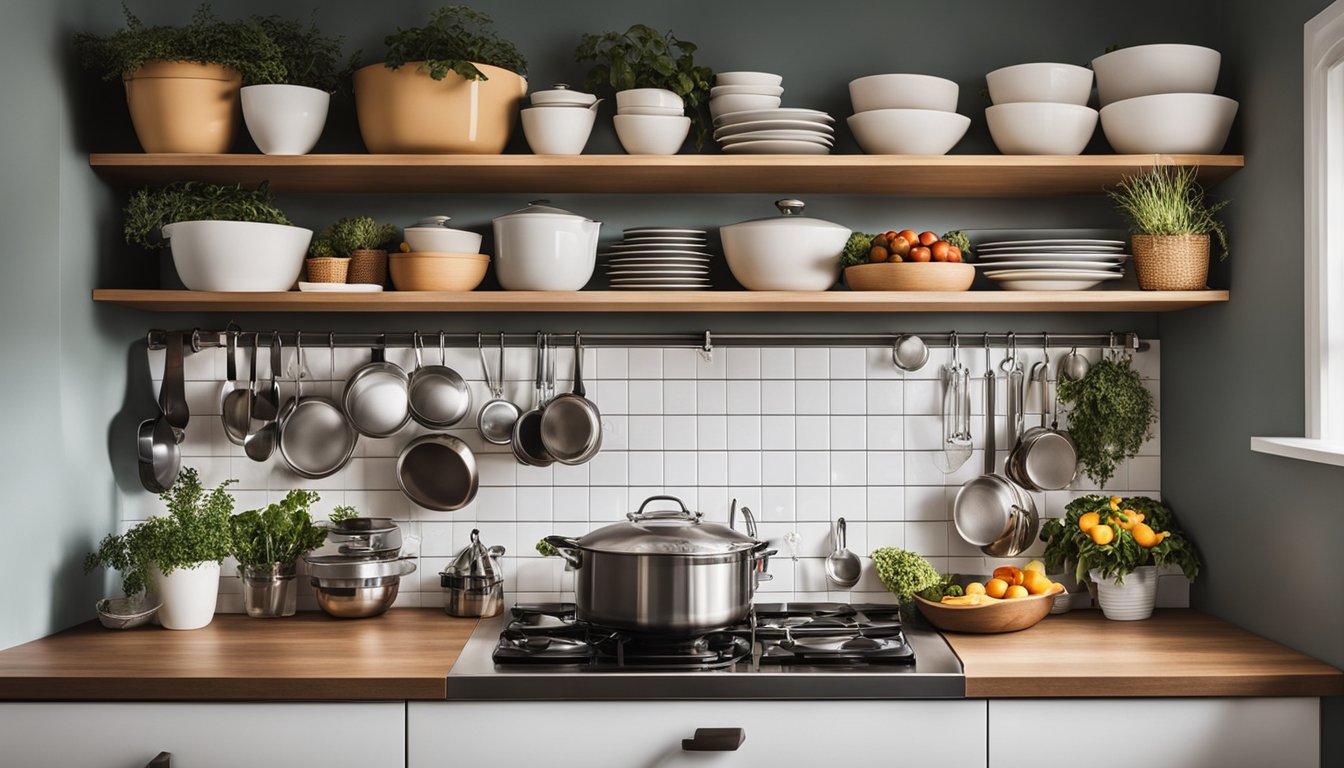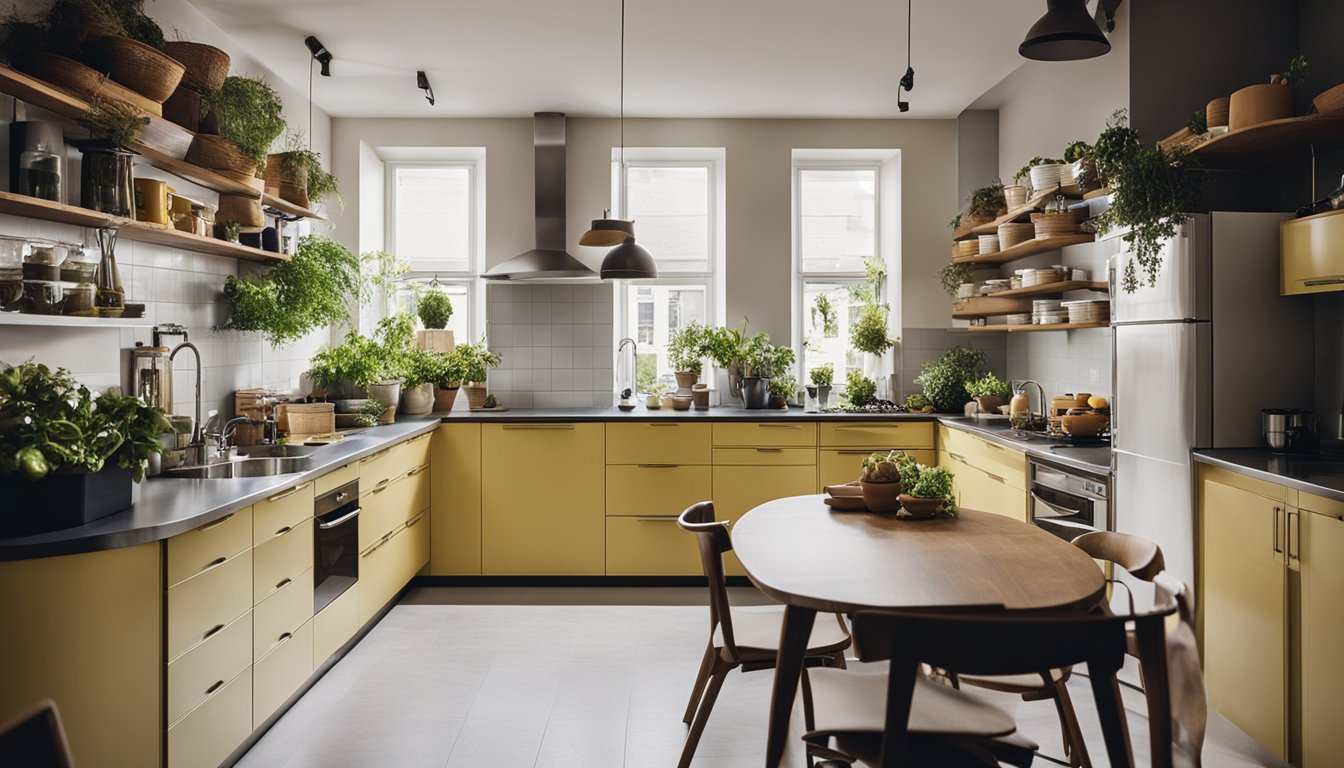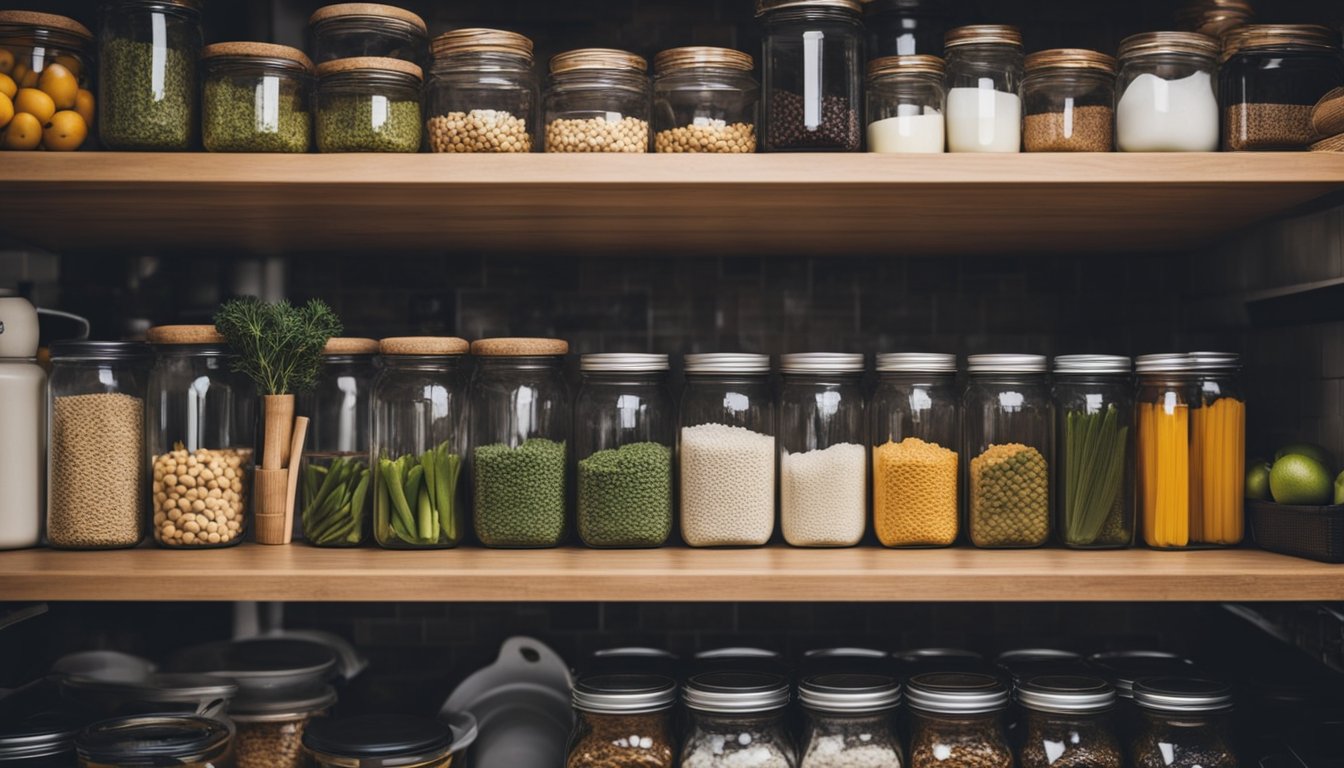Late updated: 28 Feb 2025 11:02
Written by: Sarah Hollister
Sustainable Kitchen Storage Ideas for Small Spaces: Maximising Efficiency
Creating an organised kitchen in a small space is often challenging, but it is by no means impossible. By incorporating sustainable kitchen storage ideas, we not only maximise our space but also contribute to a more eco-friendly lifestyle. Opting for sustainable solutions in our tiny kitchens helps us manage clutter while ensuring that every inch is put to good use.

In our quest to enhance both functionality and sustainability, we can explore options like vertical storage, pull-out drawers, and utilising corners effectively. These clever storage solutions not only reduce waste but also make our cooking areas more efficient. Investing in compact, energy-efficient appliances can also help us maintain an organised kitchen space.
Balancing practicality with sustainability requires a thoughtful approach to selecting the right storage solutions. Together, we can transform our small kitchens into spaces that are not only efficient but also kind to the planet.
Key Takeaways
- Sustainable storage solutions maximise small kitchen spaces.
- Efficient use of corners and vertical storage enhances organisation.
- Energy-efficient appliances support an eco-friendly kitchen.
Maximising Space with Smart Storage Solutions
In compact kitchens, optimising every square inch is essential. We explore storage strategies that transform small areas into highly efficient workspaces without sacrificing aesthetics or functionality. From vertical expansion to innovative fittings, these solutions promote seamless organisation and accessibility.
Utilising Vertical Space for Storage Efficiency
Effective use of vertical space can significantly enhance storage capacity in a small kitchen. Floating shelves and open shelving create opportunities to display and access frequently used items without cluttering countertops.
Adding pegboards provides versatile storage for cooking utensils, keeping them within easy reach. Vertical shelves and under-shelf baskets can also maximise wall space. These solutions allow us to utilise the height of our kitchens, keeping floors clear and adding to the open, airy feeling.
Innovative Furniture and Fixtures
Incorporating multi-functional furniture is crucial in small kitchens. A small kitchen island or kitchen cart provides additional workspace and neatly hides storage cabinets while enhancing mobility.
Rolling carts serve as adaptable storage options that can be repositioned as needed. A hanging pot rack saves cupboard space and adds a rustic appeal, perfect for keeping pots and pans readily accessible. These fixtures blend style with practicality, optimising the use of available space.
Optimisation of Drawers and Cabinets
Making the most of our existing drawers and cabinets enhances storage without requiring major renovations. Implementing pull-out drawers and pull-out shelves within cabinets improves the accessibility of items stored at the back, reducing the barrier of inconvenient depth.
Drawer organizers such as drawer dividers partition spaces efficiently, allowing for orderly storage of cutlery and tools. Investing in a cabinet organiser converts crowded areas into fully accessible storage spots, ensuring that the entire space is used efficiently. Together, these enhancements lead to a more organised and functional kitchen environment.
Sustainability and Functionality in Small Kitchens

Emphasising sustainability and functionality in small kitchens involves clever design choices and eco-friendly practices. From organising kitchen spaces efficiently to integrating elements that minimise environmental impact, small kitchens can be both practical and sustainable.
Rethinking Kitchen Organisation and Accessories
In our quest to enhance functionality, kitchen islands serve as versatile assets. They provide extra prep space, storage, and can even function as dining areas in tiny house kitchens. Utilising magnetic spice racks and magnetic knife racks keeps often-used items within easy reach, freeing counter space.
Incorporating lazy susans and shelf risers in cabinets maximises storage and accessibility. These items help keep everything organised and reduce clutter. Hanging pots and pans maximises vertical space, which is ideal for a minimalist or open-concept kitchen.
Implementing Sustainable Practices
Adopting sustainable practices includes using eco-friendly materials. Reclaimed wood and bamboo for storage units reduce environmental impact. Natural light is an essential component, decreasing reliance on artificial lighting and conserving energy.
Adopting reusable containers and jars for food storage minimises plastic use. Incorporating spice storage solutions like glass jars helps reduce waste. Designing kitchens with materials that support easy cleaning and maintenance also plays a crucial role in sustainability.
Through these methods, we can create small kitchens that are not only efficient in design but also environmentally friendly. Embracing sustainability while optimising space benefits both our living environment and the planet.
Frequently Asked Questions

Exploring kitchen storage solutions for small spaces can significantly enhance both functionality and sustainability. Efficient organisation and budget-friendly options are key aspects of this journey.
What are the most efficient ways to organise a small kitchen without cabinets?
To maximise space without cabinets, vertical shelving is invaluable. Corner shelves and wall-mounted racks allow for the use of otherwise neglected areas. Plate racks, standalone pantries, and under-sink organisers create dedicated spots for different items, maintaining order.
How can one optimise storage within a tight budget in a compact kitchen?
Affordable solutions include repurposing existing items—such as using mason jars for holding utensils or mounting a pegboard for hanging kitchen tools. Flea markets and thrift stores offer cost-effective storage gems like baskets or old crates that add both charm and functionality.
What are the best practices for DIY sustainable storage solutions in limited kitchen spaces?
Embrace repurposing by transforming wine crates into rustic shelves or turning glass jars into storage containers. Minimalistic hooks on walls serve as perfect spots for hanging pots or mugs. Upcycling materials like wood pallets to build custom shelves is both eco-friendly and personalised.
Can you suggest any space-saving kitchen layouts suitable for small areas?
The galley kitchen layout is a prime choice, with two parallel counters maximising workspace and storage. The L-shaped layout adapts well to corners, providing open floor space, while kitchen islands with built-in shelves offer additional storage without compromising mobility.
What strategies are available for storing small kitchen appliances to maximise space when not in use?
Tuck appliances away in cabinets with swing-out shelves for easy access. Over-cabinet storage can house infrequently used gadgets, freeing up counter space. Consider using appliance garages with lift-up doors or rolling carts that transport tools to where they're needed.
How does one efficiently utilise freestanding storage to declutter a small kitchen?
Freestanding units like tiered shelving or mobile kitchen trolleys provide flexibility and additional storage wherever it's needed most. These units offer adjustable shelving spaces perfect for storing a variety of kitchen necessities without a permanent installation, preserving adaptability.
